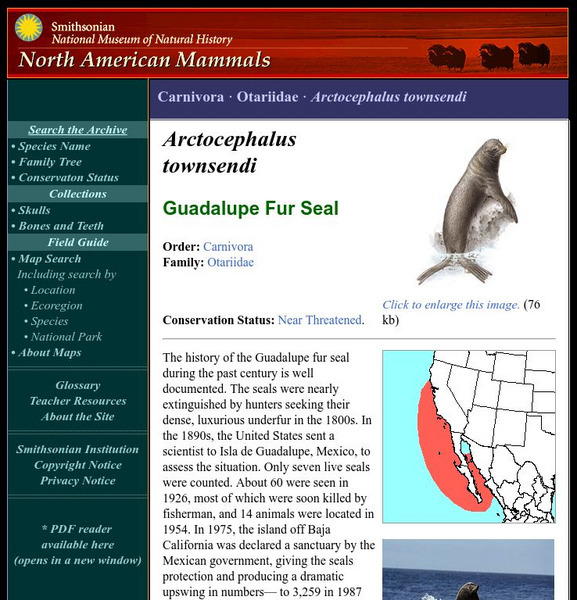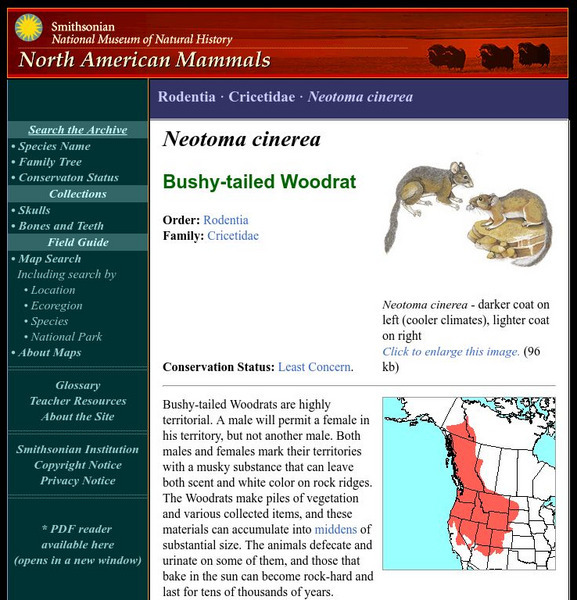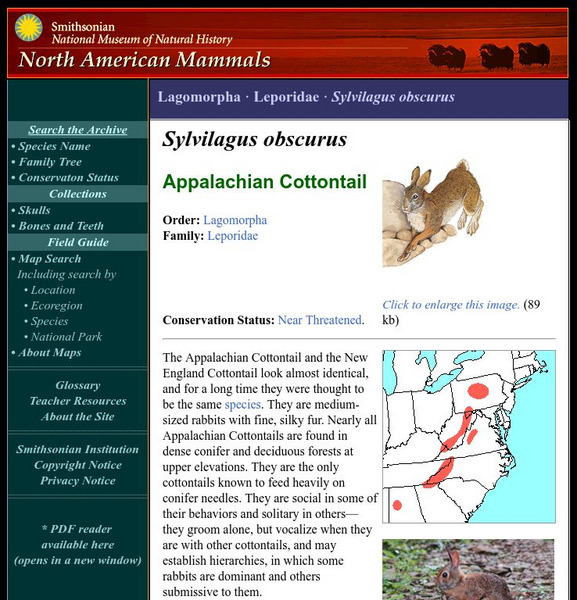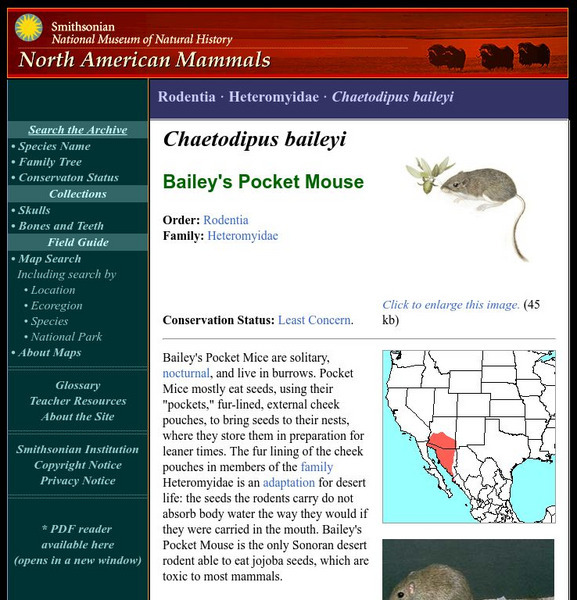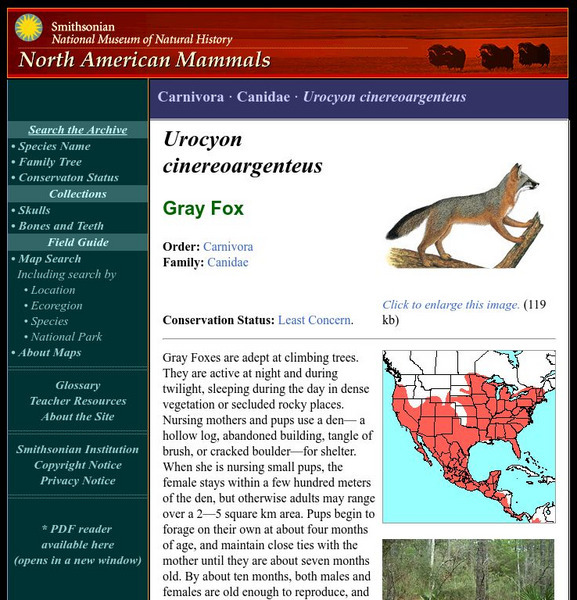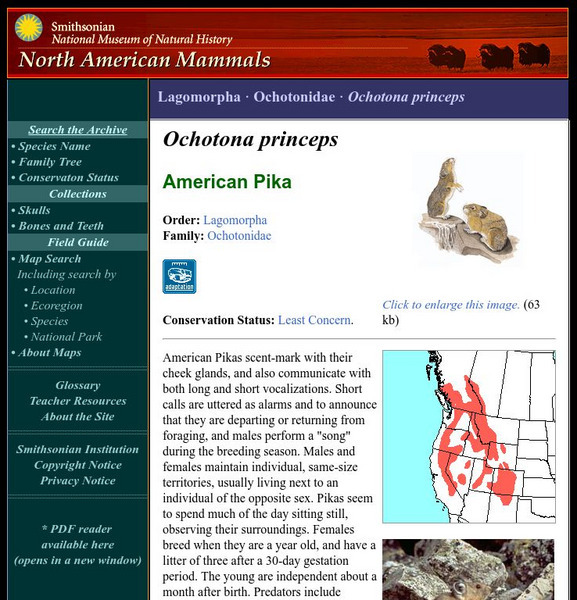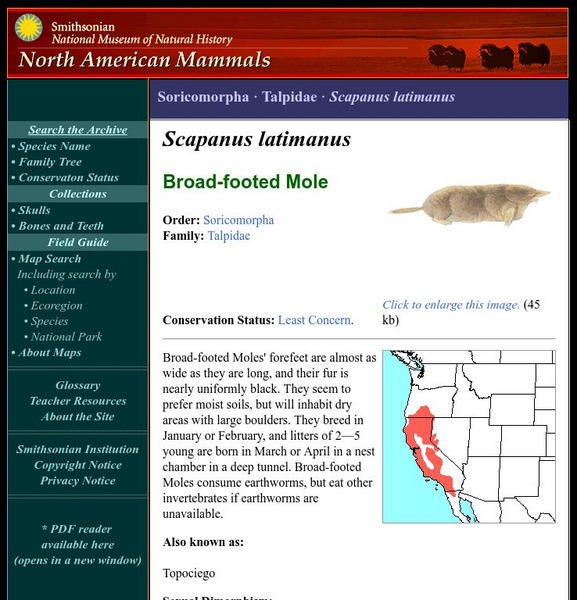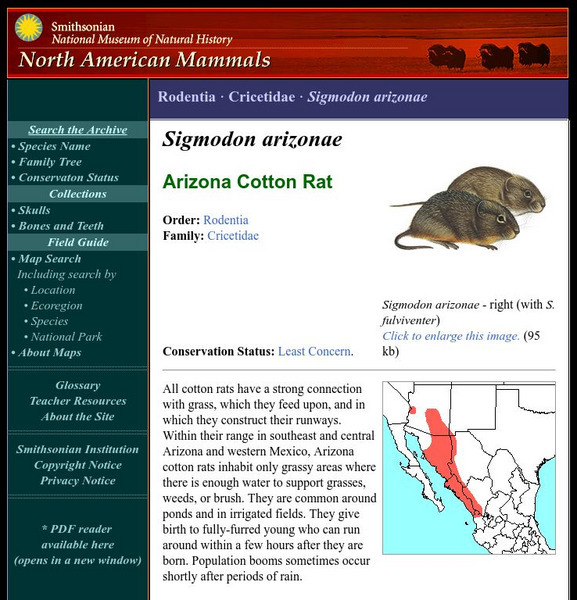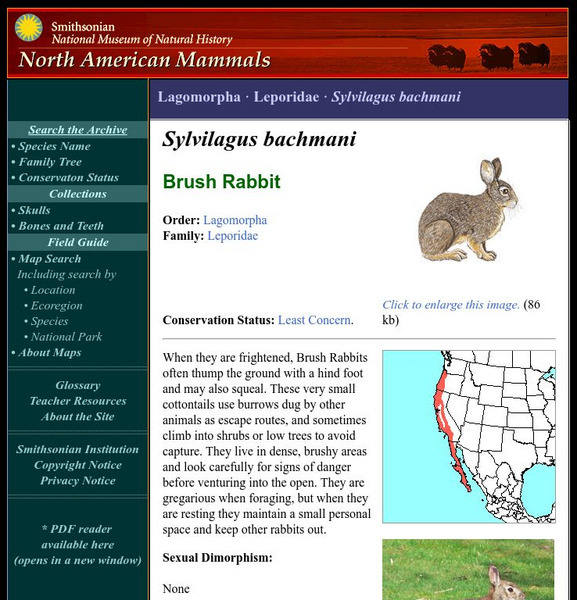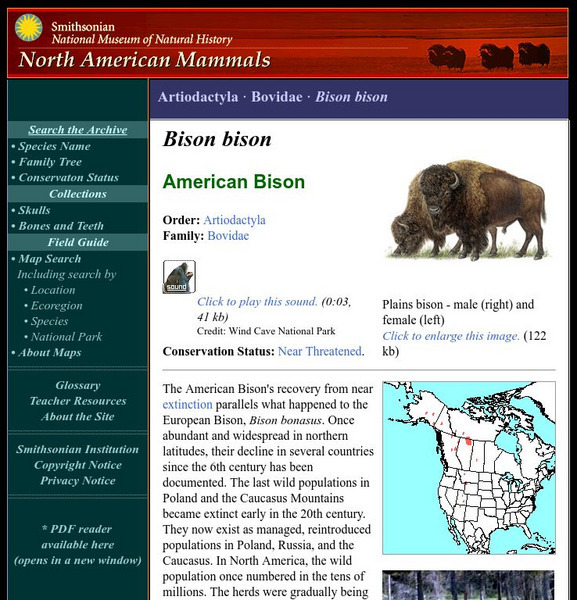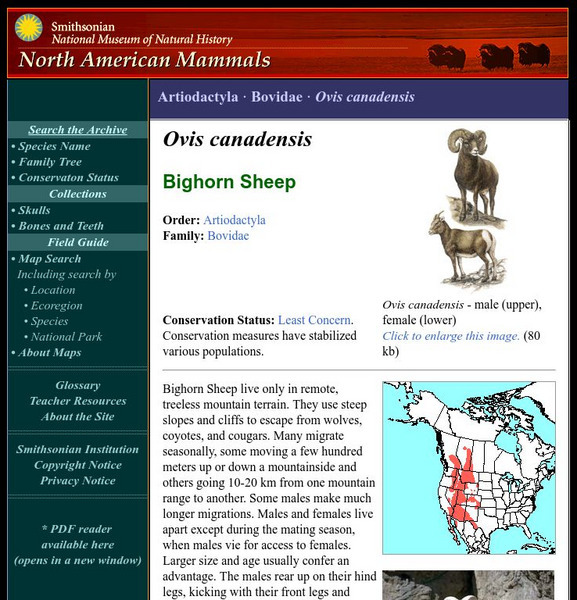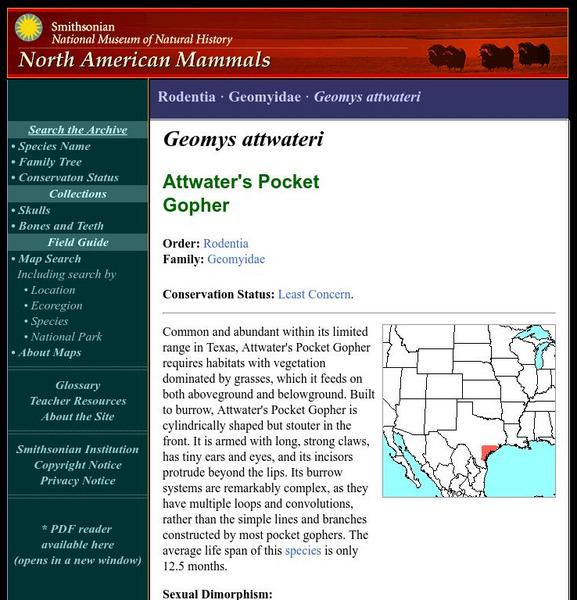Smithsonian Institution
National Museum of Natural History: American Mammals: Guadalupe Fur Seal
The history of the Guadalupe fur seal during the past century is well documented. The seals were nearly extinguished by hunters seeking their dense, luxurious underfur in the 1800s. Learn more about the Arctocephalus townsendi, more...
Smithsonian Institution
National Museum of Natural History: American Mammals: Bushy Tailed Woodrat
Bushy-tailed Woodrats are highly territorial. A male will permit a female in his territory, but not another male. Learn more about the Neotoma cinerea, more commonly known as a Bushy-tailed Woodrat, in this easy-to-read species overview...
Smithsonian Institution
National Museum of Natural History: American Mammals: Arizona Pocket Mouse
Like other heteromyid rodents, Arizona Pocket Mice are solitary creatures. They spend the day in underground burrows, emerging only at night. Learn more about the Perognathus amplus, more commonly known as an Arizona Pocket Mouse, in...
Smithsonian Institution
National Museum of Natural History: American Mammals: Cotton Deermouse
A medium-sized rodent with large ears and eyes, the Cotton Deermouse is dark golden-brown above with white underparts and feet. It is very similar to the white-footed Mouse, with which it breeds in captivity. Learn more about the...
Smithsonian Institution
National Museum of Natural History: American Mammals: Appalachian Cottontail
The Appalachian Cottontail and the New England Cottontail look almost identical, and for a long time they were thought to be the same species. They are medium-sized rabbits with fine, silky fur. Learn more about the Sylvilagus obscurus,...
Smithsonian Institution
National Museum of Natural History: American Mammals: Bailey's Pocket Mouse
Bailey's Pocket Mice are solitary, nocturnal, and live in burrows. Pocket Mice mostly eat seeds, using their "pockets," fur-lined, external cheek pouches, to bring seeds to their nests, where they store them in preparation for leaner...
Smithsonian Institution
National Museum of Natural History: American Mammals: Common Gray Fox
Gray foxes are adept at climbing trees. They are active at night and during twilight, sleeping during the day in dense vegetation or secluded rocky places. Learn more about the Urocyon cinereoargenteus, more commonly known as a Common...
Smithsonian Institution
National Museum of Natural History: American Mammals: Bobcat
The Bobcat is the most widely distributed native cat in North America. Bobcats occupy many habitat types, from desert to swamp to mountains. Learn more about the Lynx rufus, more commonly known as a Bobcat, in this easy-to-read species...
Smithsonian Institution
National Museum of Natural History: American Mammals: American Pika
American Pikas scent-mark with their cheek glands, and also communicate with both long and short vocalizations. Short calls are uttered as alarms and to announce that they are departing or returning from foraging, and males perform a...
Smithsonian Institution
National Museum of Natural History: American Mammals: Broad Footed Mole
Broad-footed Moles' forefeet are almost as wide as they are long, and their fur is nearly uniformly black. They seem to prefer moist soils, but will inhabit dry areas with large boulders. Learn more about the Scapanus latimanus, more...
Smithsonian Institution
National Museum of Natural History: American Mammals: Arizona Cotton Rat
All cotton rats have a strong connection with grass, which they feed upon, and in which they construct their runways. Within their range in southeast and central Arizona and western Mexico, Arizona cotton rats inhabit only grassy areas...
Smithsonian Institution
National Museum of Natural History: American Mammals: Brush Rabbit
When they are frightened, Brush Rabbits often thump the ground with a hind foot and may also squeal. These very small cottontails use burrows dug by other animals as escape routes, and sometimes climb into shrubs or low trees to avoid...
Smithsonian Institution
National Museum of Natural History: American Mammals: American Black Bear
Most Black Bears hibernate for up to seven months, and do not eat, drink, urinate, or exercise the entire time. In the South, where plant food is available all year, not all bears hibernate, but pregnant females do. Learn more about the...
Smithsonian Institution
National Museum of Natural History: American Mammals: American Marten
American Martens are widely distributed in northern forests across Canada and into Alaska. Only 200 years ago, they were also abundant in the southeastern United States. Learn more about the Martes americana, more commonly known as an...
Smithsonian Institution
National Museum of Natural History: American Mammals: American Bison
The American Bison's recovery from near extinction parallels what happened to the European Bison, Bison bonasus. Once abundant and widespread in northern latitudes, their decline in several countries since the 6th century has been...
Smithsonian Institution
National Museum of Natural History: American Mammals: Bighorn Sheep
Bighorn Sheep live only in remote, treeless mountain terrain. They use steep slopes and cliffs to escape from wolves, coyotes, and cougars. Learn more about the Ovis canadensis, more commonly known as a Bighorn Sheep, in this...
Smithsonian Institution
National Museum of Natural History: American Mammals: Coast Mole
Coast Moles are difficult to distinguish from Townsend's Moles where their ranges overlap in the Pacific Northwest. Both have velvety, dark-gray fur and tiny eyes and ears that are hidden under their fur. Learn more about the Scapanus...
Smithsonian Institution
National Museum of Natural History: American Mammals: Baird's Shrew
Baird's Shrew has a very limited range in Oregon, in moist conifer forests. Its fur is darker brown in winter than in summer, when it is brownish-chestnut or olive-brown, with paler sides and belly. Learn more about the Sorex bairdi,...
Smithsonian Institution
National Museum of Natural History: American Mammals: Arizona Shrew
The Arizona Shrew was at first found only in Arizona, but it is now known to occur in New Mexico and northern Mexico as well. Until the 1990s, only about 22 specimens had ever been collected. Learn more about the Sorex arizonae, more...
Smithsonian Institution
National Museum of Natural History: American Mammals: Arctic Shrew
Arctic Shrews prefer grassy clearings and marshes within coniferous forests and are never very dense in population. Mortality is high early in life. Learn more about the Sorex arcticus, more commonly known as an Arctic Shrew, in this...
Smithsonian Institution
National Museum of Natural History: American Mammals: Cinereus Shrew
Mainly nocturnal and rarely seen, the Cinereus Shrew is nonetheless common and widespread below the timberline in northern deciduous and coniferous forests, in both wet and dry habitats. It is also known as the Masked Shrew and the...
Smithsonian Institution
National Museum of Natural History: American Mammals: American Badger
Badgers look like short, shaggy, medium-sized dogs. They are powerful diggers. Learn more about the Taxidea taxus, more commonly known as an American Badger, in this easy-to-read species overview by the Smithsonian's National Museum of...
Smithsonian Institution
National Museum of Natural History: American Mammals: Attwater's Pocket Gopher
Common and abundant within its limited range in Texas, Attwater's Pocket Gopher requires habitats with vegetation dominated by grasses, which it feeds on both aboveground and belowground. Built to burrow, Attwater's Pocket Gopher is...
Smithsonian Institution
National Museum of Natural History: American Mammals: Blue Whale
As far as we know, the blue whale is the largest animal ever to have existed on the planet. Weights up to 190,000 kg (as much as 30-40 African elephants) have been recorded. Learn more about the Balaenoptera musculus, more commonly known...
